Astronomical wristwatches - a path through the Universe
The astronomical watches are mechanical watches, which, in addition to basic functions (hours, minutes, seconds), show the time of day, date, moon phases, celestial position of the Sun, the Moon, the Earth and other planets. Such watches also include the Ptolemaic system of the world and the Planetarium of Copernicus, showing the astrological aspects at any time.
Science of the Universe
 The catholic priest and writer The catholic priest and writer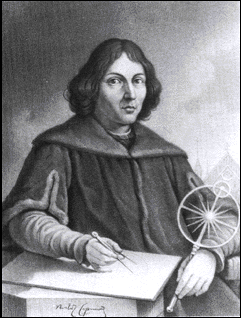 Anthony de Mello (1931 - 1987) once wondered why people, who knew a word like "wisdom", thought they knew what it was about, but understanding the meaning of "Astronomy", nobody became an astronomer. Sure, astronomy is one of the oldest and most complex sciences, which originated in far XXV - XXIII centuries BC. To fully understand the above definition of astronomical watches, it is necessary to clarify some astronomical facts (for those who did not want to become an astronomer). So, great Claudius Ptolemy offered the so-called geocentric system, in which the planets were situated according to the distance from the Earth, around which the Sun, the Moon, planets and stars go. Some historians blame Ptolemy for falsification of data and plagiarism, claiming that he had "stolen" the information from the works of Hipparchus, and interpreted them incorrectly. Well, let's not argue with the researchers. In any case, the court isn’t able to read the indictment to Ptolemy no longer. The Ptolemy's theory was "improved" by Nicholas Copernicus, who proposed the heliocentric system of the world where the Sun is the central celestial body, around which planets go. For us, dear readers, such superficial knowledge in astronomy is sufficient, since we are interested in direct connection of the science of the Universe with time meters. Anthony de Mello (1931 - 1987) once wondered why people, who knew a word like "wisdom", thought they knew what it was about, but understanding the meaning of "Astronomy", nobody became an astronomer. Sure, astronomy is one of the oldest and most complex sciences, which originated in far XXV - XXIII centuries BC. To fully understand the above definition of astronomical watches, it is necessary to clarify some astronomical facts (for those who did not want to become an astronomer). So, great Claudius Ptolemy offered the so-called geocentric system, in which the planets were situated according to the distance from the Earth, around which the Sun, the Moon, planets and stars go. Some historians blame Ptolemy for falsification of data and plagiarism, claiming that he had "stolen" the information from the works of Hipparchus, and interpreted them incorrectly. Well, let's not argue with the researchers. In any case, the court isn’t able to read the indictment to Ptolemy no longer. The Ptolemy's theory was "improved" by Nicholas Copernicus, who proposed the heliocentric system of the world where the Sun is the central celestial body, around which planets go. For us, dear readers, such superficial knowledge in astronomy is sufficient, since we are interested in direct connection of the science of the Universe with time meters.
And the time proved to be quite closely connected with astronomy and the universe, as the clock for the first in the world was created by nature itself. Implausible? Then what is the alternation of day and night, the motion of the Sun, the evolution phases of the moon, if not the most accurate first "natural clock"? For many centuries people used those natural clocks (the Sun - clock, and the Moon - calendar), and that was quite enough for them. But after a mechanical clock was rapidly developed, the celestial bodies lost their dominant role in the measurement of time. Everything turned upside down – then the watchmakers, all-powerful "masters of the time," began to paint the movement of celestial bodies on the dials of their watches, creating unique, first tower, wall clocks, and then pocket and wrist astronomical watches.
Brilliant ancestors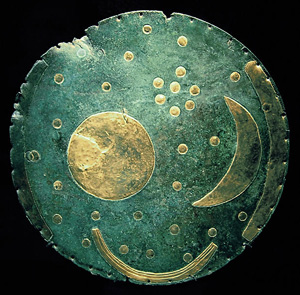
In 1999, in 180 km to the south-west of Berlin (Saxony-Anhalt) a unique item - a bronze Nebra disc of 30 cm in diameter, covered with patina, with inlays of gold, representing the Moon, the Sun and 32 stars, was found. And that relic wasn’t excavated by archaeologists, but by violators of graves, going for the ancient values. The violators, who tried to sell the artifact in 2001, which belonged to Germany by law, were captured during a special operation in Basel (interestingly, this is the legendary Swiss city, which annually hosts the prestigious exhibition of watches). For several years, the destination of ancient disk remained a mystery to modern scientists, and only four years later the secret was discovered. As it turned out, the bronze disk of Nebra is nothing but an oldest and perhaps the first astronomical clock in the world, quite complex in some respects. The researchers concluded that the ancient Europeans knew what was the difference between solar and moon calendars, and the celestial disk helped them to coordinate two calendars. The sensation is that the people of the Bronze Age (and the finding relates to the XVII century BC!) could bring both calendars in conformity with each other. As it turned out, our ingenious forefathers enjoyed that disc for 300 years, and then it became an object of religious cult. Now I want to say the words of Shakespeare, "There are more things in heaven and earth, Horatio, than are dreamed of in your philosophy!". It turns out that we strongly underestimated the ancient nation that was able to be sensitive enough to understand the time and astronomy. After all aforesaid it’s a bit uncomfortable to talk about the first primitive astronomical clock, represented by the sundial of the ancient Egyptians. However, the sundial is a prototype of the astronomical clock, though quite elementary.
"Mechanical" Astronomy
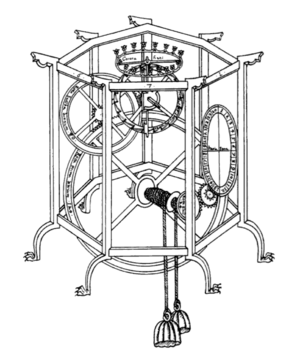 To say that the first mechanical astronomical clock appeared long time ago, it would be like to announce that the statue "Spring Buddha" in China is just a high statue, though it is the biggest statue in the world - the giant of 153 m height. The subject of our conversation today - astronomical watches – is known to the world since time immemorial in a literal sense. There are only assumptions concerning the date of the appearance of mechanical clocks, but reliable information, unfortunately, is absent. Presumably, the mechanical astronomical clock created by Italian watchmaker Giovanni Dondi is one of the first complex time meters of its kind. Completed in 1364, Dondi’s astronomical clock hasn’t “reached” to the present day, but its detailed description, drawn by the author, survived. That clock showed the mean solar time, the time of sunrise and sunset, and the motion of the Sun, Moon, Mars, Venus, Saturn, Mercury, and Jupiter, totally 7 objects in the Universe. In addition, the Dondi’s clock had dials, which showed the date of Easter and other church events. Considering the high technical complexity of the astronomical clock by Dondi, we can conclude that clock was not the first To say that the first mechanical astronomical clock appeared long time ago, it would be like to announce that the statue "Spring Buddha" in China is just a high statue, though it is the biggest statue in the world - the giant of 153 m height. The subject of our conversation today - astronomical watches – is known to the world since time immemorial in a literal sense. There are only assumptions concerning the date of the appearance of mechanical clocks, but reliable information, unfortunately, is absent. Presumably, the mechanical astronomical clock created by Italian watchmaker Giovanni Dondi is one of the first complex time meters of its kind. Completed in 1364, Dondi’s astronomical clock hasn’t “reached” to the present day, but its detailed description, drawn by the author, survived. That clock showed the mean solar time, the time of sunrise and sunset, and the motion of the Sun, Moon, Mars, Venus, Saturn, Mercury, and Jupiter, totally 7 objects in the Universe. In addition, the Dondi’s clock had dials, which showed the date of Easter and other church events. Considering the high technical complexity of the astronomical clock by Dondi, we can conclude that clock was not the first clocks of the Universe, and became only an improved version of previously created simpler astronomical clocks. After decoding the mysterious finding’s value from Germany though, one cannot draw any conclusions unsubstantiated by historical facts about the possibilities of our ancestors. Many historical and cultural monuments are still perplexing the scientists of the XXI century. Think of at least one of the wonders of the world - Egyptian Pyramids! clocks of the Universe, and became only an improved version of previously created simpler astronomical clocks. After decoding the mysterious finding’s value from Germany though, one cannot draw any conclusions unsubstantiated by historical facts about the possibilities of our ancestors. Many historical and cultural monuments are still perplexing the scientists of the XXI century. Think of at least one of the wonders of the world - Egyptian Pyramids!
But let’s go back to clocks. The giant tower clock in Italy (Krimona), created by Francesco and Giovanni Divitsioli, which dates back to around XIII century, is one of the most famous ancient astronomical clocks. This clock shows the Sun, going by the zodiac signs. The clock in Bern, Switzerland, installed on the tower Zeitglockenturm in the XIII century, and the astronomical clock of the XIV century of British Wales, reflecting the model of the universe, are very interesting. In France, in Strasbourg, to this day three astronomical clocks, installed in 1352, 1547, and 1838 .jpg) have been preserved. In the clock that was built in Sweden (Lund) two knights show hours, astronomical dials - moon phases, sunrise and sunset, and more, and with the help of calendar people know the dates of religious holidays. have been preserved. In the clock that was built in Sweden (Lund) two knights show hours, astronomical dials - moon phases, sunrise and sunset, and more, and with the help of calendar people know the dates of religious holidays.
The huge astronomical clocks, located on the towers, gradually passed into the category of personal use. People began to "spy" for the time first from their pockets, and then moved the astronomical watches to the wrists. The modern man ceased to be guided by the solar time long ago, but the astronomical wristwatches are still popular and, moreover, they acquired the status of one of the most difficult watches in technical terms. The astronomical wristwatches are a huge pride of the world watch companies with great names - Audemars Piguet, Martin Braun, Ulysse Nardin, Patek Philippe, A. Lange & Sohne, IWC, LLeroy, Parmigiani Fleurier, Patek Philippe, Roger Dubuis and others.
Celestial bodies on the wrist
.jpg) .jpg) The main difference of The main difference of.jpg) astronomical clocks from usual ones (although one it is difficult to call a watch, for example, with repeater, tourbillon, and other complications, “usual”, nevertheless, we’ll take this rough classification) is that the astronomical wristwatch is capable to display the actual motion of celestial bodies in one way or another. Thus, the ingenious watchmakers manage to place the objects of our universe on miniature dials of watches. The most popular celestial body in the watch industry is the Moon, the phase indicators of which occur in astronomical wristwatches most often. Frankly, this design is considered to be the simplest in execution, so the indicator of the moon phases is often combined with a perpetual calendar to a greater effect. astronomical clocks from usual ones (although one it is difficult to call a watch, for example, with repeater, tourbillon, and other complications, “usual”, nevertheless, we’ll take this rough classification) is that the astronomical wristwatch is capable to display the actual motion of celestial bodies in one way or another. Thus, the ingenious watchmakers manage to place the objects of our universe on miniature dials of watches. The most popular celestial body in the watch industry is the Moon, the phase indicators of which occur in astronomical wristwatches most often. Frankly, this design is considered to be the simplest in execution, so the indicator of the moon phases is often combined with a perpetual calendar to a greater effect.
The watchmakers do not sidestep the brightest star, named “The Sun”, which is associated with two complex functions of astronomical wristwatches. They are the time of sunrise / sunset and the equation of time, which are the rarest watch functions. The watch companies that offer their customers to admire the sunset and sunrise are the best known Audemars Piguet and Ulysse Nardin, and such astronomical watches certainly need to be configured on the geographical coordinates of the location, where the owner of the watch wants to see sunset or sunrise. The second function - the equation of time - is the difference between common time scale, in which the length of day is the same all year round (24 hours), and solar time. Because of its technical complexity the function of the equation of time is an adornment of the most difficult watches, and its execution is the pride of the world watch companies. Some of the most important Swiss "time equalizers" are Audemars Piguet (men's wristwatch “Jules Audemars Equation of Time”), Breguet (watch “Classique Equation of Time”), and Jaquet Droz (model “Equation du Temps”). Sometimes there is another unusual function associated with the Sun, showing the eleven-year cycle of solar activity, i.e. the totality of changing phenomena on the Sun (sunspots, solar flares, solar fibers, coronal holes, etc.). I would venture to suggest that the "solar" function is unnecessary, although, perhaps, a curious watch owner, in addition to reading the time, just needs to see changes in solar activity to be aware of weather changes, pressure, rainfall, etc. For those interested in natural phenomena, or for those who just need to be interested in them, the watchmakers have introduced another unique function into their universe creations, which, oddly enough, is directly related to the Sun. This is an indicator of tides, which are "governed" by the Moon and the Sun, at that the first celestial body plays a crucial role, causing.jpg) ebbs at intervals of 12 hours 25 minutes. The Swiss watch “Corum Admiral's Cup Marees” will help you to trace the movements of water. Unlike the Sun, our planet Earth is seen on the astronomical watch dials very rare. The indicator of line, separating the illuminated side of Earth from the night, can serve as an example. ebbs at intervals of 12 hours 25 minutes. The Swiss watch “Corum Admiral's Cup Marees” will help you to trace the movements of water. Unlike the Sun, our planet Earth is seen on the astronomical watch dials very rare. The indicator of line, separating the illuminated side of Earth from the night, can serve as an example.
There are also watches, so-called "mini-planetariums", the dials of which show celestial sphere with the stars, planets and satellites. I think, there’s no need to talk about the incredible complexity of this trend in the watch industry, because everything is clear without words. I’ll give just one example: the watch of the Swiss company “Ulysse Nardin”, called “Planetarium Copernicus” and released in a single piece, was included in the "Guinness Book of Records". This fact shows a high level of the watch company brighter than any praise.
Another result of the watchmakers’ travel around the universe is a sky map, which miraculously "materialized" on the owner's wrist. Of course, the dial shows only the part of the sky that is visible above the horizon, so these watches relate exclusively to a particular geographic location. One of the most famous and the first watches with a sky map is the pocket astronomical watch “Supercomplication”, manufactured by the Swiss company “Patek Philippe” at the beginning of last century specially for its main client, the American automobile tycoon, Ward Packard, the dial of which accurately reflected the position of the stars over the house of the American in Ohio.
Types of "constellations" of astronomical watches
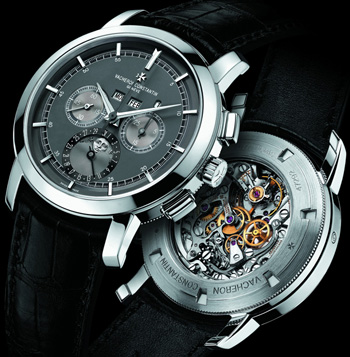 The specialists of the watch industry, speaking about astronomical wristwatches, often distinguish four classic types or, as I literally named them, four "constellations" of such time meters, which are produced by many watch companies with great names. I want to note, however, that this classification is rather simplistic, due to the large number of existing astronomical functions, listed above and embodied in life by the masters of watchmaking all over the world. You’ll make sure in it now. The specialists of the watch industry, speaking about astronomical wristwatches, often distinguish four classic types or, as I literally named them, four "constellations" of such time meters, which are produced by many watch companies with great names. I want to note, however, that this classification is rather simplistic, due to the large number of existing astronomical functions, listed above and embodied in life by the masters of watchmaking all over the world. You’ll make sure in it now.
It is logical to start with the first and simplest type of astronomical wristwatches, equipped with such functions, as indicator of Moon phases and full calendar. These watches are characterized by hand indicator of date, as it is convenient to combine with the Moon phase indicator, and apertures of week day and month. It's simple.
The second type is astronomical wristwatches with Moon phase indicator, triple calendar and chronograph. There is also a hand-type date indicator (combined with the Moon phase), apertures with the current month and day of the week. The extra function - chronograph - does not overload the dial of watches.
The third type - wrist watch with the Moon phase indicator and perpetual calendar. This is the most common type of astronomical watches. I will say more – there is practically no astronomical watch with perpetual calendar and without Moon phase indicator (or vice versa). The "friendship" of these two functions is so strong that it’s been lasting since time immemorial to the present day.
And finally, the fourth classics from the watchmakers-astronomers - wristwatch with Moon phase indicator, perpetual calendar and chronograph. Looking at the dial of such watches for the first time, the buyer might be confused, because in addition to the Moon phase indicator, the watch is provided with some more hands. Let's count them. For example: hour and minute hands, chronograph’s central second hand, minute and hour counters, additional dial with small second hand, indicators of date, month, day, leap year. I counted 10 hands. And this is the minimum number. Although the dial looks pretty loaded, the watch looks proud, serious and very expensive. Why only Looks though? It is so!
The modern design of new models of astronomical watches suggests the presence of the Moon phase and big date indicators, which have recently been widespread. As noted above, these are only the basic, classic types of astronomical wristwatches, which are often complicated by other functions, associated with the movements of celestial bodies. After all, the modern watchmakers’ fantasy knows no bounds, and the technical possibilities are improving every year, resulting in a radically new level of sophistication and quality of astronomical wristwatches, both male and female. Astronomical watches are a certain link in the entire history of the world, where the past and the present are intertwined with each other. They are unique "particles of the Universe," which, believe me, will live forever, as long as the galaxy exists. Maybe, these are too loud words, but think about it: different civilizations come and go, but the stars, both in the sky and on the dials of our watches, always shine!
Men’s watch Arnold & Son True North Perpetual (REF.1QPAW.B02A.C20BD)
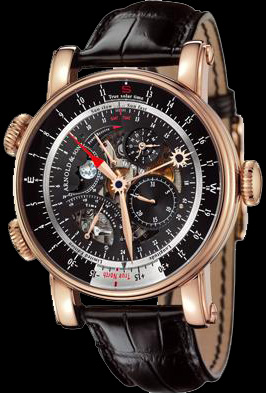 It seems that the famous Swiss watch company “Arnold & Son” was inspired by the appearance of space equipment and by the mysterious, alluring beauty of the immense Universe for the creation of unique astronomical watch “True North Perpetual” with reference 1QPAW.B02A.C20BD. The men's watch from Arnold & Son “True North Perpetual” became the center of a kind of "concentration" of striking and necessary functions for astronomical watch. Many innovations that the company used when creating that masterpiece for the first time had been patented. The manual winding movement of caliber A1794, which power reserve is enough for seven days, is characterized by the revolutionary technology of gear design that is very important for so many hand indicators on the watch dial of Arnold & Son True North Perpetual. In addition to its basic function as a "demonstrator" of standard current time, the men's wristwatch by Arnold & Son “True North Perpetual” plays a large number of additional roles, showing the world from the other side, astronomical side, and telling its owner about our planet and the mighty Universe. It seems that the famous Swiss watch company “Arnold & Son” was inspired by the appearance of space equipment and by the mysterious, alluring beauty of the immense Universe for the creation of unique astronomical watch “True North Perpetual” with reference 1QPAW.B02A.C20BD. The men's watch from Arnold & Son “True North Perpetual” became the center of a kind of "concentration" of striking and necessary functions for astronomical watch. Many innovations that the company used when creating that masterpiece for the first time had been patented. The manual winding movement of caliber A1794, which power reserve is enough for seven days, is characterized by the revolutionary technology of gear design that is very important for so many hand indicators on the watch dial of Arnold & Son True North Perpetual. In addition to its basic function as a "demonstrator" of standard current time, the men's wristwatch by Arnold & Son “True North Perpetual” plays a large number of additional roles, showing the world from the other side, astronomical side, and telling its owner about our planet and the mighty Universe.
The first function of this watch that deserves our attention is the perpetual calendar. It's no secret that sooner or later one get tired of constantly adjusting the date in the calendar, depending on the number of days in the current month, as well as taking into account leap years. The men's watch “Arnold & Son True North Perpetual” makes this work for you. The manual adjustment, as the manufacturers claim, will be required only in special 2100. The point is that on the 14 of March, 2100, the difference between the Julian (old) and Gregorian (new) calendar will make up 14 days, and this date corresponds to February 29 under the old (Julian) calendar, the day, which is missing in 2100 (non-leap year). Such an unusual phenomenon will lead to necessity to adjust the date, showed by all wristwatches with perpetual calendars. The astronomical wristwatch “Arnold & Son True North Perpetual” is not an exception. So, the hand indicator of the date is located at "4" hours, and the indicator of the month and leap year - at around "1" hour.
The following function is designed for the true astronomers – the indicator of Moon phases is between "9" and "10" hours on the dial of True North Perpetual. This indicator is as accurate as possible, since over 122 years the deviation will make up only one day. You can see that this is absolutely a minor divergence. Besides, I doubt that any of present owners of True North Perpetual will be lucky enough to see that. The watch “Arnold & Son True North Perpetual” also has one of the most complicated astronomical functions - a function of the equation of time, which is read by an additional dial at around "7" hours, and is also available for viewing on the rotating bezel of the watch. for the true astronomers – the indicator of Moon phases is between "9" and "10" hours on the dial of True North Perpetual. This indicator is as accurate as possible, since over 122 years the deviation will make up only one day. You can see that this is absolutely a minor divergence. Besides, I doubt that any of present owners of True North Perpetual will be lucky enough to see that. The watch “Arnold & Son True North Perpetual” also has one of the most complicated astronomical functions - a function of the equation of time, which is read by an additional dial at around "7" hours, and is also available for viewing on the rotating bezel of the watch.
The indicator of solar time, presented in the Swiss watch “Arnold & Son True North Perpetual” as a 24-hour scale on the rotating bezel, is a quite rare astronomical function too. The principle of this function is based on the knowledge that the current real (familiar to us) time may vary, depending on a particular time zone. But the solar time, on the contrary, depends on the position of the planet on the elliptical orbit and the position of the Sun on the celestial sphere. You see, the astronomy will not let you get bored!
And finally, perhaps, the most unusual and unique feature of this watch from Arnold & Son - display of the true North. It works quite originally. Once a day, when the hand with a tip in the form of the sun indicates the noon by solar time, the owner of the watch might experience wonderful excitement and awe - feelings that no other watch is able to provoke. Regardless of the effect of magnetic fields, location of the watch’s owner and the current date, the rotating bezel of astronomical time meter will show the geographic north.
And finally, briefly about the other basic characteristics of the watch. The case of 45 mm diameter, made of chic pink 18-carat gold, shimmers brilliantly (there are variants in white and red gold), the transparent back case is made of sapphire crystal, which also protects the partially skeletonized black dial (there are models with gray and blue dials). The water resistance is low - 30 meters. In addition to these astronomical features, the time meter displays hours and minutes (central hands), and the indicator of 168-hour power reserve is located at "11 hours". The image of the model is completed by the black (or brown) leather strap with gold buckle. I want to add that this astronomical watch is created for those, who want to be constantly in close connection not only with his home planet, but also with the whole Solar System.
Men’s watch Patek Philippe Celestial (Ref. 6104G)
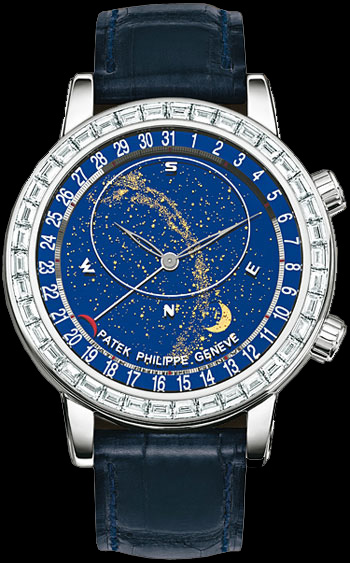 Another brilliant creation of a powerful company “Patek Philippe”. Another fantastic watch masterpiece of Swiss craftsmanship. This is the men's wrist watch “Patek Philippe Celestial” (Ref. 6104G). When you look at this watch, it seems as if you set off on a journey in a spaceship through the Universe and see the "drifting" by heavenly bodies through the window. Perhaps, this men's wristwatch is the most futuristic time meter ever created. In addition, this mechanical watch will make us look around and see the beauty of the world that we simply do not notice. Indeed, for many centuries people admired the stars, and now the modern man would prefer to watch luxury car’s headlights, flying on the highway. Another brilliant creation of a powerful company “Patek Philippe”. Another fantastic watch masterpiece of Swiss craftsmanship. This is the men's wrist watch “Patek Philippe Celestial” (Ref. 6104G). When you look at this watch, it seems as if you set off on a journey in a spaceship through the Universe and see the "drifting" by heavenly bodies through the window. Perhaps, this men's wristwatch is the most futuristic time meter ever created. In addition, this mechanical watch will make us look around and see the beauty of the world that we simply do not notice. Indeed, for many centuries people admired the stars, and now the modern man would prefer to watch luxury car’s headlights, flying on the highway.
Probably, the fans of the Swiss watch company “Patek Philippe” will wonder, why, when speaking about astronomical watches, I don’t describe in detail the well-known by all lovers of watches model “Patek Philippe Sky Moon”. It's simple - the aforementioned Sky Moon is so complex, beautiful and famous that any description will be somewhat incomplete, it will not be able to transfer the beauty and grace of this watch. I’ll note that the astronomical indicators in Sky Moon, in contrast to Celestial, are located on the back case of the model. The men's watch “Patek Philippe Celestial” (Ref. 6104G) isn’t inferior to its "big brother" in any way, and its magnificence is emphasized by amazing and sparkling diamonds, adorning the bezel and buckle (there is also a less "decorated" version without jewels of reference 5102RP). According to some experts of luxury watches, the precious model of Patek Philippe “Celestial” is a great option not only for men, but for women, who are a bit "deprived" of time meters with astronomical functions. And why not?
Thus, the general characteristics of Celestial. The men’s (or women’s) watch from Patek Philippe “Celestial 6104G” is made of white gold of 18 carats, the case is 44 mm in diameter and 10 mm in thickness (average size, which will look great on a female wrist). The fixed gold bezel is encrusted with 38 baguette-cut diamonds (total weight of 4.27 carats), the blue dial is protected by scratch-resistant sapphire crystal. The transparent back case is also made of sapphire glass. The "engine" of wrist watch is represented by an automatic movement of caliber “Patek Philippe 240 LU CL”, assembled from 301 elements and working at 45 stones with a 48-hour power reserve. The water resistance of case - 30 meters (almost absent, but this is not the most important thing in this model). The watch is equipped with two crowns, adorned with the brand logo – Calatrava cross. One of the crowns is designed for winding and time adjustment (at "2" hours), the second one – for correction of astronomical indicators (at "4" hours). The men's watch “Patek Philippe Celestial 6104G” is equipped with a dark-blue alligator leather strap with hand stitching and gold buckle, encrusted by 22 baguette-cut diamonds with total weight of 1.13 carats.
I’ve saved the functions of this masterpiece watch "for dessert." These are, of course, standard hours, minutes, date, and an indicator of solar time, the time of Moon and Sirius (one of the closest stars to the Earth) going through the meridian, an indicator of lunar time, sky map, phase and orbit of the Moon. An impressive list! The date is indicated by the central hand with a red crescent-shaped tip. The sky map on the dial of the watch from Patek Philippe produces the exact position of the stars above Geneva, and the gold skeletonized hands are moving, pointing to the numerals, applied by serif font. The main idea of this watch consists in three transparent disks on the dial, rotating at different speeds. The first translucent disk is the image of the sky map; the second disc determines the orbit of the Moon; and the third one is the disk of the Moon phases. The men's watch from Patek Philippe “Celestial 6104G” is a unique masterpiece, which shows as many as four measurements of time. These are the lunar time, i.e. the time between two successive passages of the Moon by the meridian, each lasting 24 hours 50 minutes 28 seconds, then the lunar month, or the time between two full moons - 29 days 44 minutes 3 seconds, the sidereal time - the time, required to the Star to make a full pass by a given meridian (23 hours 56 minutes 4 seconds), and the usual time (24 hours). Do I need to explain that placing all these complex astronomical functions in a single watch model was incredibly difficult? The watchmakers of Patek Philippe tried about 25 trillion different combinations before they have reached the most exact relations for the movement. The deviations that might occur are incredibly small: lunar time - 0.05 sec / day, lunar month - 6.5 sec / month, sidereal time - 0.08 sec / day. The manufacture of each model of watches “Celestial” from Patek Philippe took the masters about 18 months, and the Swiss company produces 35 pieces of the unique astronomical time meter a year. All parts of the movement (301) are processed manually, and the steel parts are carefully polished and beveled that allowed achieving maximum accuracy and reliability of the movement. The rotor is made of 22-carat gold. Each model has the “Poincon de Geneve” - an indicator of the highest level of excellence and the Swiss quality.
And the last thing I would like to add, speaking of this wristwatch. I see a certain poetry and profound philosophy in it; this is a watch that lives its "universe" eternal life. You cannot change this life, stop, restart, or adjust for yourself. The watch “Celestial” of Patek Philippe as if reminds you that whatever you do, the time in the Universe is determined to go forward. You can only (but why only?) hope that this kind of "window into the sky map" will decorate your life, teach you how to dream!
Men’s watch DeWitt Academia Quantieme Perpetuel GMT Nebula (ref. AC.7021.35.M1001)
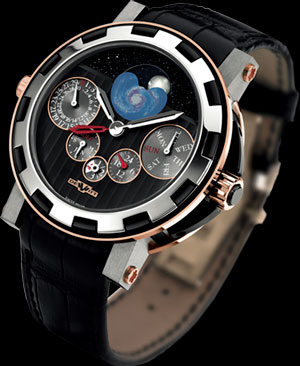 The Swiss watchmaker “DeWitt” also contributed to the development of astronomical "time keepers", releasing a magnificent men’s watch “Academia Quantieme Perpetuel GMT Nebula” (ref. AC.7021.35.M1001). This Swiss watch has become an honorary representative of the "time astronomy". The company drew inspiration to create such a masterpiece from the beauty and mystique of the boundless galaxy, as proved by the name of the watch – “Nebula”. Opening the dictionary of astronomical terms, I learned that Nebula is a mist phenomenon N6C in the constellation “Eridanus”, located in 85 million light-years from the Earth. Such an amazing spiral galaxy, situated on a silicon plate of the dial (of course, in reduced scale) became "the main character" of the astronomical wristwatch from DeWitt. The Swiss watch “Academia Quantieme Perpetuel GMT Nebula” is a true masterpiece of highly complex design, which strongly emphasizes the subtle craftsmanship of miniaturization. The white mother-of-pearl Moon moves at star sky, represented in the form of Murano glass, and the indicator of Moon phases is an artistic image of nebula. The Swiss watchmaker “DeWitt” also contributed to the development of astronomical "time keepers", releasing a magnificent men’s watch “Academia Quantieme Perpetuel GMT Nebula” (ref. AC.7021.35.M1001). This Swiss watch has become an honorary representative of the "time astronomy". The company drew inspiration to create such a masterpiece from the beauty and mystique of the boundless galaxy, as proved by the name of the watch – “Nebula”. Opening the dictionary of astronomical terms, I learned that Nebula is a mist phenomenon N6C in the constellation “Eridanus”, located in 85 million light-years from the Earth. Such an amazing spiral galaxy, situated on a silicon plate of the dial (of course, in reduced scale) became "the main character" of the astronomical wristwatch from DeWitt. The Swiss watch “Academia Quantieme Perpetuel GMT Nebula” is a true masterpiece of highly complex design, which strongly emphasizes the subtle craftsmanship of miniaturization. The white mother-of-pearl Moon moves at star sky, represented in the form of Murano glass, and the indicator of Moon phases is an artistic image of nebula.
The case, making up 44 mm in diameter and 13.35 mm in thickness, is a combination of precious materials - 18-karat white and red gold (bezel, back case), titanium (sides of the case) and black ceramics. The crown is presented by red 18-karat gold. The guilloched dial of deep black color is decorated with the pattern "Cotes de Geneve" (there is also a version with gray dial of reference AC.7021.35.M1001). The upper part of the dial of extraordinary beauty with images of twinkling stars is made of unique material “Goildfluss”, which is a synthetic glass, invented in the XVII century in Venice by Miotti family. The men's wristwatch “Academia Quantieme Perpetuel GMT Nebula” is equipped with such great complexity, as perpetual calendar. The additional small gray dials, which look like miniature planets, are situated around the mother-of-pearl Moon and blue nebula. So, right to left – hand indicator of week day, 24-hr watch scale, leap year indicator, current month indicator, hand indicator of date (the numerals marked on the outer ring of an additional dial are odd, on the inner ring - even). The indicator of phases of the Moon is at "12 hours". The central red skeletonized hand shows GMT or second time zone, which is adjusted by means of additional crown at "9" hours. This astronomical masterpiece is provided with vital energy by automatic caliber DW7021, operating at 37 stones with a frequency of 28,000 vibrations per hour. The power reserve is approximately 42 hours. On the sides of the gold case of “Academia Quantieme Perpetuel GMT Nebula” there are 4 buttons for adjustment of perpetual calendar indicators at "2", "4", "8" and "10" hours. The back transparent case of sapphire glass allows to observe the work of highly accurate Swiss movement. The Swiss watch is equipped with black crocodile leather strap with a buckle, made of titanium. All elements of this watch, joining together, create great harmony. Everyone knows that the stars and other celestial bodies are too far to achieve, but the almighty watchmakers, not paying attention to this statement, are trying to do it. And as it turns out, not in vain.
|


